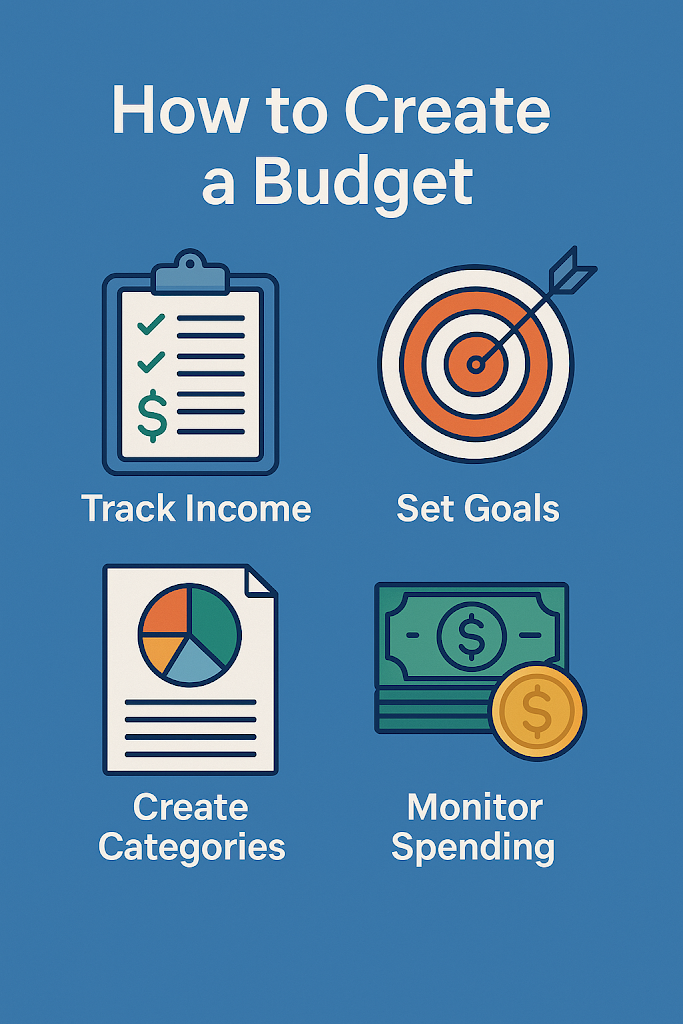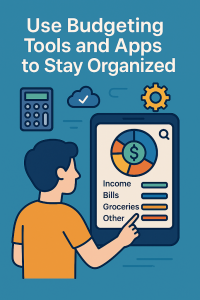Learning how to create a budget is one of the most empowering steps you can take toward financial freedom. Whether you’re trying to get out of debt, save for a vacation, or simply stop living paycheck to paycheck, a well-planned budget gives you clarity, control, and confidence in your financial life.
In this guide, we’re not going to offer generic advice like “spend less than you earn” or “save more.” Instead, you’ll find practical, actionable strategies, tools, and examples that you can start using today. Whether you’re a student, a young professional, or managing a household, this article will help you build a budget that truly works for you.
Understanding Why a Budget Matters
Before diving into the mechanics of how to create a budget, it’s important to understand the “why.” A budget isn’t about restriction—it’s about intention. It helps you tell your money where to go instead of wondering where it went.
Here are just a few reasons to prioritize budgeting:
- Control: Take charge of your financial decisions instead of reacting to unexpected bills.
- Clarity: Know exactly how much money is coming in and going out each month.
- Goals: Allocate funds toward saving, investing, or paying off debt with a clear plan.
- Peace of Mind: Reduce stress and avoid financial surprises.
Once you’re clear on why a budget matters, it becomes easier to stay consistent and motivated.
Track Your Income and Expenses Accurately
One of the biggest mistakes people make when figuring out how to create a budget is underestimating or forgetting certain expenses. That’s why the first and most critical step is to track your income and spending patterns honestly and thoroughly.
Income tracking tips:
- Include all sources—salary, freelance gigs, rental income, government benefits, etc.
- Use your net income (after taxes) for the most realistic picture.
Expense tracking methods:
- Use budgeting apps like YNAB or Mint.
- Download your last three bank and credit card statements and categorize every transaction.
- Create simple categories like Housing, Food, Transportation, Debt Payments, and Entertainment.
Once you’ve gathered this data, you’ll start seeing patterns. Maybe you’re spending $250 a month on delivery or $100 on subscription services you barely use. This awareness alone can be eye-opening.
Set Financial Goals That Motivate You
A solid budget is driven by purpose. That’s why setting personal financial goals is a key step in how to create a budget that actually sticks. When your money is working toward something meaningful, you’ll be much more motivated to follow your plan.
Here are some examples of short-, medium-, and long-term goals:
- Short-term (1-12 months): Build an emergency fund, pay off a credit card, save for a trip.
- Medium-term (1-5 years): Buy a car, fund a wedding, start investing.
- Long-term (5+ years): Buy a home, save for retirement, achieve financial independence.
Be specific and set deadlines. Instead of “save more,” try “save $3,000 for an emergency fund within 6 months.” This helps you reverse-engineer your budget to make that goal possible.
Choose a Budgeting Method That Fits Your Lifestyle
One of the most overlooked aspects of how to create a budget is choosing the right framework for your personality and lifestyle. Not all budgeting styles are created equal, and what works for one person may feel restrictive to another.
Here are four popular budgeting methods you can try:
- Zero-Based Budget: Every dollar has a job. Income minus expenses equals zero. Great for detail-oriented people.
- 50/30/20 Rule: Allocate 50% to needs, 30% to wants, and 20% to savings/debt repayment. Simple and balanced.
- Envelope System: Allocate physical cash or digital “envelopes” to categories. Helps control overspending.
- Pay Yourself First: Save/invest a fixed percentage of your income before spending the rest. Ideal for saving-focused people.
Try one for a month and tweak as necessary. Your first budget doesn’t need to be perfect—it just needs to be a start.
Create Budget Categories and Allocate Realistic Amounts
This step in how to create a budget involves breaking down your monthly income into categories and assigning realistic amounts to each. The key word here is “realistic.” If you eat out five times a week, budgeting $20 for restaurants is setting yourself up for failure.
Core budgeting categories:
- Housing (rent/mortgage, utilities)
- Food (groceries, restaurants, coffee)
- Transportation (gas, public transit, maintenance)
- Debt Payments (credit cards, loans)
- Savings & Investments (emergency fund, retirement)
- Personal & Lifestyle (subscriptions, clothes, hobbies)
Use averages from your past three months of spending to guide your allocation. As your habits change, so will your budget. That’s perfectly normal.
Review and Adjust Your Budget Every Month
One of the most important principles in how to create a budget that works long-term is recognizing that your financial situation will change over time. Your budget shouldn’t be static—it should evolve with your life.
At the end of each month, take 15-20 minutes to review your actual spending compared to your budgeted amounts. Where did you overspend? Where did you underspend? What surprised you?
Here’s how to adjust your budget effectively:
- Look at the big picture: Did your total expenses exceed your income?
- Identify patterns: Are you consistently overspending in certain categories like food or entertainment?
- Make realistic tweaks: If your grocery budget is always off by $50, increase it instead of feeling guilty.
- Update goals: If you reached a goal early, set a new one and reallocate funds.
Remember, flexibility is key. Learning how to create a budget is not about being perfect—it’s about being consistent and aware.
Use Budgeting Tools and Apps to Stay Organized
Technology can make budgeting much easier, especially if spreadsheets aren’t your thing. There are dozens of free and paid tools designed to help you track your income, categorize your expenses, and visualize your progress.
Here are some of the most effective tools to support your budgeting journey:
- You Need a Budget (YNAB) – Great for zero-based budgeting and goal tracking.
- Mint – A free option that links to your accounts and auto-categorizes transactions.
- Goodbudget – Excellent for envelope budgeting, both digital and manual.
- Spreadsheets (Google Sheets or Excel): Highly customizable and great for DIYers.
Pick one tool and stick with it for at least two months. Avoid jumping between apps—consistency builds momentum. The goal isn’t perfection but having visibility and accountability for where your money is going.
Manage Irregular Expenses Without Breaking Your Budget
Many people give up on budgeting because they’re caught off guard by “unexpected” costs—car repairs, medical bills, or annual subscriptions. But here’s the truth: most of these are not unexpected; they’re just irregular.
Part of how to create a budget that actually works is accounting for these expenses ahead of time using a method called “sinking funds.”
What are sinking funds? They are small monthly savings allocations for larger, infrequent expenses.
Examples of sinking funds:
- Car maintenance
- Holiday gifts
- Back-to-school supplies
- Pet care
- Insurance premiums (quarterly or annual)
If you know your car insurance is $600 every six months, save $100/month toward it. When the bill comes due, you won’t feel the financial shock—it’s already covered.
Stay Consistent and Make Budgeting a Habit
Once you’ve learned how to create a budget, the next step is forming the habit of sticking to it. Consistency is what transforms budgeting from a temporary project into a lifestyle that supports your financial goals.
Here are tips to help you stay on track:
- Schedule “money dates” weekly: Set 10–15 minutes aside to review your budget and spending.
- Automate savings and bill payments: This reduces decision fatigue and missed due dates.
- Track small wins: Celebrate when you pay off a debt, build an emergency fund, or stay under budget.
- Get a budgeting buddy: Having someone to share progress with adds accountability.
Over time, budgeting won’t feel like a chore—it will feel like a normal and rewarding part of life. You’ll gain more confidence in your decisions, and money will stop being a source of stress.
Using Credit Cards Responsibly Within Your Budget
Credit cards can be a valuable financial tool—or a budget killer—depending on how you use them. A big part of how to create a budget that’s sustainable is knowing where credit fits in.
Smart credit card usage tips:
- Pay your balance in full every month—never carry interest if you can avoid it.
- Use cards for planned expenses only—like groceries or bills—and track them in your budget.
- Leverage rewards programs—but not as an excuse to overspend.
- Set up alerts to avoid missing payment due dates.
If you tend to overspend with credit, consider using cash or a debit card until your budgeting habits improve. Responsible credit use can boost your credit score and provide extra protections, but it must be handled with discipline.
Prepare for Financial Setbacks Without Derailing Your Budget
No matter how well you plan, life will throw you curveballs. Part of mastering how to create a budget is accepting that unexpected costs will come—and preparing for them ahead of time.
This is where your emergency fund comes in. An emergency fund acts as a buffer for life’s financial surprises, like a medical emergency, job loss, or a broken appliance.
Tips to build an emergency fund:
- Start small: Aim for $500 to $1,000 as your initial goal.
- Automate monthly transfers to a high-yield savings account.
- Cut unnecessary spending temporarily to speed up the process.
Having this fund keeps your budget intact when things go wrong. It prevents you from dipping into credit or ruining months of careful planning.
Develop the Right Mindset for Long-Term Success
You can learn all the technical steps of how to create a budget, but without the right mindset, it’s hard to stay consistent. Budgeting is less about math and more about habits, patience, and discipline.
Mindset shifts that make a difference:
- Progress, not perfection: A missed goal or overspending doesn’t mean failure—adjust and continue.
- Discipline equals freedom: Saying “no” now creates more opportunities later.
- Focus on your why: Tie your budget to something meaningful—like peace of mind or freedom to travel.
When you see your budget as a tool that empowers you—not restricts you—it becomes much easier to commit long-term.
Real-Life Examples of Budgeting in Action
To better understand how to create a budget that adapts to different life situations, here are a few simplified examples based on common scenarios:
1. Single professional earning $3,000/month
- Rent: $1,000
- Utilities & internet: $200
- Groceries: $300
- Transportation: $150
- Debt repayment: $250
- Savings: $400
- Discretionary: $300
- Buffer/emergency: $400
2. Family of four with combined income of $6,000/month
- Housing: $1,600
- Utilities & subscriptions: $500
- Groceries: $900
- Transportation: $400
- Kids’ expenses: $300
- Savings & investments: $1,000
- Insurance & medical: $400
- Entertainment: $300
- Buffer/emergency: $600
These examples show how flexible a budget can be. The goal is to find a system that fits your unique lifestyle while still prioritizing your goals.
Final Thoughts on Building a Budget That Works
Now that you’ve learned how to create a budget, the key is taking action. Start small. Choose a budgeting method, track your spending, and give yourself grace as you adjust. Over time, you’ll build a system that feels natural and helps you live intentionally.
Budgeting is more than just a financial tool—it’s a form of self-care. It empowers you to make thoughtful decisions, reduce stress, and achieve the goals that matter most to you. And the best part? Anyone can learn it.
Now it’s your turn: What challenges have you faced with budgeting? What’s worked—or not worked—for you? Share your experiences in the comments below. Your story could inspire someone else.
Frequently Asked Questions (FAQ)
What is the best method for creating a budget?
There’s no one-size-fits-all answer. The best method depends on your personality, goals, and financial habits. Zero-based budgeting is great for control, while the 50/30/20 method offers simplicity. Try one and tweak it based on what feels sustainable.
How often should I update my budget?
Ideally, review your budget weekly and update it monthly. This keeps you on track and allows you to adjust for unexpected expenses or changes in income.
What if I overspend in one category?
Overspending happens. Look at your total monthly budget and see if you can shift funds from another category. If not, make a plan to balance it out next month. The key is not to give up.
Can I use cash only for budgeting?
Yes! Many people use the envelope method, where they allocate cash into labeled envelopes for each category. It can be effective for those who tend to overspend with cards.
How do I budget with an irregular income?
Base your budget on your lowest expected income month. Prioritize essential expenses first, and use any extra income to build a buffer or sinking funds. Flexibility and tracking are key.











